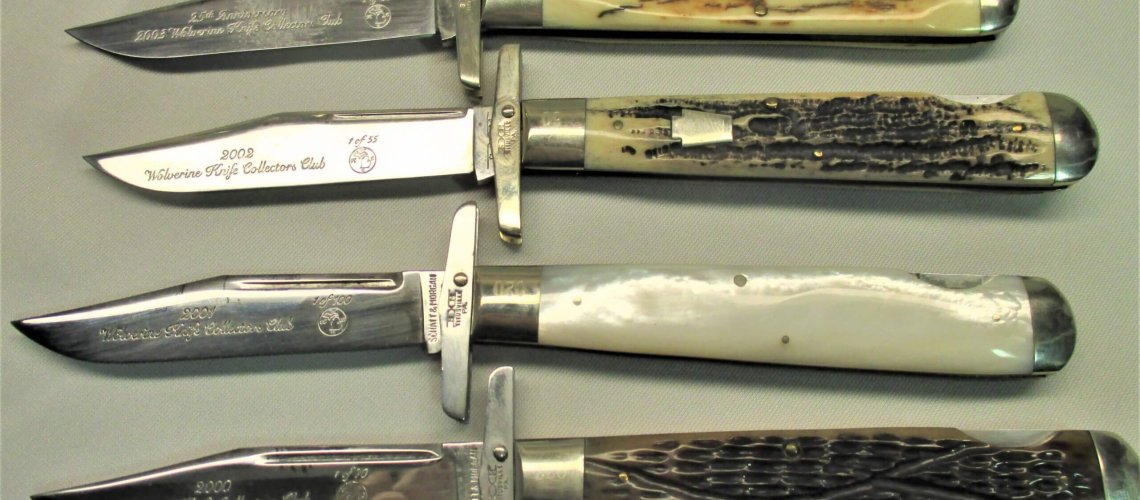
Dan Lago,
August 2023,
Introduction.
It will be too many pages to discuss 65 swing guard knives and show images of that many knives, though many are indeed beautiful cutlery. We will show some examples, but if you want to study the group in categories, it will be best to look in detail at the Excel appendix attached to these three articles. Although we recognize it is a lot to read and examine the knife photos in the first two articles in this set, it will help you see how the Special factory orders (SFO) grew directly from the catalog and special projects that Queen carried out.
First, we would like to make a distinction between “Private label” knives and “SFO knives.” MANY customers want to put their own label on a knife; they want you to think they made it and to build their own reputation by using a “jobber” – an anonymous cutlery they paid to keep silent That is “private label”. Queen has served many as a private label cutlery and it would be impossible to list all of them going back to Schatt & Morgan over 115 years ago; there are no records. But SFO knives are different. The client WANTS to take advantage of the reputation and quality of the chosen cutlery and they want some similarity to previous knives that sold well, some tang stamp identity, and packaging, as well as their own identification of providing the specific knife they have contracted. SFO knives provide a benefit to each partner and obviously were a critical economic link to the catalog and special projects shown earlier to promote Queen’s survival.
Club Knives
As knife collecting grew during the 1970s and ‘80s, knife collecting clubs and Associations grew around the country and many still exist. Queen and other cutleries were eager to develop markets with these interested customers. Our previous article, (Collector Knives for Queen Cutlery & Servotronics, 1988 -1998. – Queen Cutlery Guide) discusses this process. By the second year of the re-introduction of the Schatt & Morgan Keystone series, when swing guard were introduced, the company was producing more knife parts for each knife in a series and then offering those highly finished knives to collectors with the chance to change etches, or shields to personalize the knives for the clubs’ purposes.
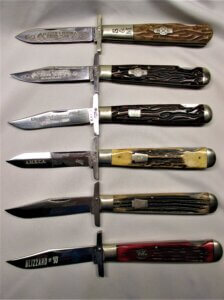
Figure 1. A sample of early Schatt & Morgan swing guards modified to become club knives. These remain a great way to obtain beautiful knives. The top two are from Mason Dixon Knife Club (2007 file and wire and 2008 brown file & Wire ), The third one is from Kansas knife Collectors (also 1998 file & Wire with their own state shield), The fourth is from Allegheny Mountain Knife Association (1995 stag Keystone), the fifth is from Southern California Blades (Schatt & Morgan 3rd Keystone series), and the final one of the bottom is also the Allegheny Mountain knife Association ’93 (based on 1992 first offering in red stag bone.) These demonstrate how marketing overrun knives of the premium series were well-used by knife clubs.
As demand increased and prices of the premium knives also grew, catalog knives were also made available. Figure 2 shows an example of the most frequent catalog knife, the Amber Carved Stag Bone (ACSB) swing guard used by at least four clubs.
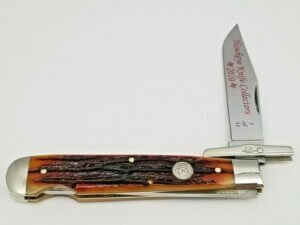
Figure 2. An Amber Carved Stag Bone (ACSB) swing guard made for the Hawkeye Knife Collectors in 2010. Many feel this catalog bone cover material was the best Queen ever used and this public Internet photo shows it off very well.
While this list is almost certainly incomplete, here is an alphabetical list of knife clubs that have ordered swing guards that have come to our attention: Allegheny Mountain Knife Association, Badger Knife Club, Chattahoochee Cutlery Club, Johnny Appleseed Knife Collectors, Hawkeye Knife Collectors, Kansas Knife Collectors Association, Mason Dixon Knife Club, Northstar Blade Collectors, Old Dominion Knife Collectors, Riverland Knife Collectors, Southern California Blades, Wolverine Knife Club, .
There is no contest here, but in our opinion, Wolverine Knife Club has earned an image for buying the most swing guards (four) in a high quality, programmatic way. Figure 3, displays their knives for the period 2000 through 2003. A very impressive set.
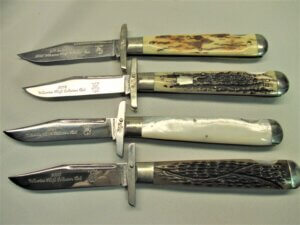
Figure 3. Four Wolverine Knife Club swing guards. From bottom to top, first, antique green bone (70); second, Mother of pearl (100); third, carved stag bone (55); fourth, polished mammoth ivory (50). (edition sizes in parentheses).
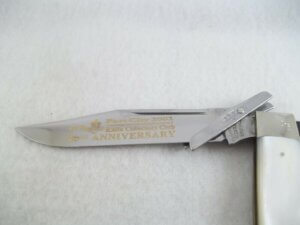
Figure 4. A Fort City Knife Collectors Club, 2001, mother of pearl swing guard demonstrating how availability of large mother of pearl covers in this pattern was quickly shared with willing buyers. We think this was the last of the large pearl for big swing guard knives.
Commercial Knife Sellers.
It is no surprise that Smokey Mountain Knife Works (SMKW). Who already had a long, successful history with Queen in private label sales, would want a piece of the success of the Queen/Schatt & Morgan swing guard. In 1995, they placed a large order for an edition of 150 stag as “Sharp friends”, though with a Queen circular relief shield, and tang stamp, rather than the Schatt & Morgan keystone and tang. Later, they ordered another large set of 150 torched Sambar stag labeled “viewers Club” (See Figure 5). And in 2012 they again ordered another swing guard in the best-selling ACSB.
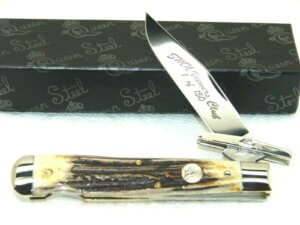
Figure 5. A stag version of Smoky Mountain Knife Works (SMKW) as “viewers Club.” One of three large purchases by this major company.
Clarence Risner was a very important seller for Queen Cutlery, serving as their national distributor for many years after the launch of the Schatt & Morgan re-introduction. He was also quick to see the value of additional Schatt & Morgan knives he could sell beyond the annual Keystone sets. We provide a sense of his role in this article: Clarence-Risner-6-11-23-second-version.pdf (secureserver.net). Attending many knife shows and with a large network of distributors, he noticed how popular the spear blades first introduced in 1994-95, in orange corncob and stag were and ordered a set in both 2001 and 2004. He insisted on top quality and superior, traditional handle materials. All his knives were issued in edition of 100 (when Queen was issuing the Schatt & Morgan “Keystones” in edition of around 600) and had an issue date etched on each blade. They are superbly designed and built knives and greatly influenced Queen’s designs and future productions. The increasing use of spear blades and reduction in edition sizes are good examples of his impact.
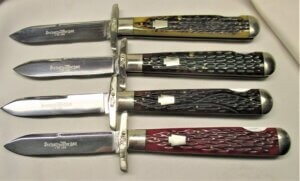
Figure 6. Clarence Risner’s SFO swing guards from 2001 2004, all issued in editions of 100. From bottom to top, first, red jigged bone; second, brown worm grooved jigged bone; third, brown corncob bone; fourth, green jigged bone.
Sooner State Knives ordered four different swing guards around 2003, with very nice handles materials, including polished feather buffalo horn (38), Candy Strip celluloid (23), Blue Chip Celluloid (few?), and polished mammoth ivory (23). These use a unique oval shield with “SSK” inscribed inside an image of Oklahoma (Figure 7). These are very hard knives to find.
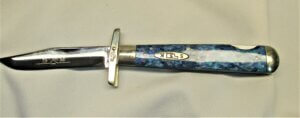
Figure 7. Sooner State knives Schatt & Morgan swing guard knife s in “blue Chip Celluloid.(So far, this celluloid has showed no signs of failure).
Queen Classics were an early project of eventual Queen owner, Kenny Daniels and were premised on the very successful Case Classic series that Queen bult for Jim Parker in the late 1190s and early 2000s. Because they demonstrate his interest in the swing guard pattern, and Queen’s interest in them during the Daniels Family era, we will spend a little more time on several examples. We show eight examples, but there might be more.
This set of knives was very carefully designed to have an unusual, traditional heraldic shield not used in any previous Queen knives, and blade etches that continued to use the heraldic symbol and showed the specific handle material used in each knife. Stag, bone, celluloid, and casein (milk protein/plastic) were used. They were produced in very limited numbers which were never publicized, but some are purported be only around 10 knives. While some of the series might have used other steels, the swing guards were all made with D2 tool steel in its first year of use by Queen, 2002. They were all boxed in unique boxes and demonstrated some of the best features of traditional collector knives. They are also not often seen and have increased in value. Figures 8,9, and 10 contain examples of these swing guards.
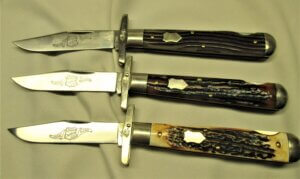
Figure 8. Queen Classics swing guards in bone and stag, with blade etches showing the handle material. From bottom to top, bottom, torched sambar stag; middle, red stag; and top, Winterbottom bone.
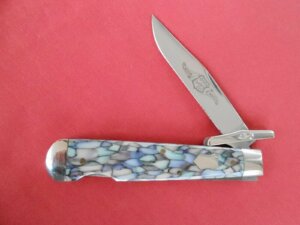
Figure 9. A Queen Classic swing guard in “abalone casein.” A very limited version. Casein is rarely seen in knife handles, but has a very good reputation for stability and durability, especially compared to celluloid products. (Internet photo).
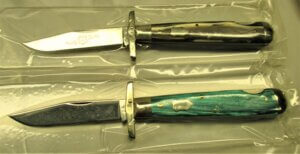
Figure 10. Two of four Queen Classic swing guards in “celluloid swirl” patterns. Bottom, blue swirl; top, chocolate swirl. Missing are a “green swirl” and a “yellow swirl”. These are all rare knives (reportedly, in editions “less than 10”). The two in the photo above are vacuumed sealed over plexiglass to try to prevent damage to other knives. Although this method appears to have worked for over 12 years, celluloid remains a concern.
Yellowhorse knives. Has made a few Queen swing guards by both David Yellowhorse and younger, Brian Yellowhorse. Because of the extensive customization and artistic quality of the finished knives, limited edition size, and competition with collectors of other Yellowhorse knives, these knives are usually the most expensive Queen/Schatt & Morgan swing guards to be seen.
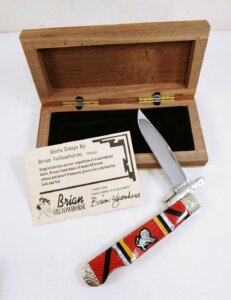
Figure 11. A Queen swing guard customized by Brian Yellowhorse, called the “the Lion, with red and black mineral inlay,” with wooden box. There is a second example, with “bear and blue and white turquoise.” A third can be seen in Figure 14. “The feather.”
Micheal Prater, Painted Pony and Yellowhorse. This collaboration created the most Queen swing guards knife versions of all time while using only about 200 individual knives; the edition size was approximately ten (10) with 18 versions noted (as far as we know!) Carried out in 2013-14, it is a dramatic example of specialization in the modern knife business to produce a large inventory of very modern swing guard knives in a short time. We are told, though without documentation, that Smoky Mountain Knife Works hoped to complete a line of custom handle Queen-produced swing guards with traditional Yellowhorse customs, but decided they needed knives quickly, and so, worked with Queen, Blue Grass Cutlery, Brian Yellowhorse, and Micheal Prater/Painted Pony, to put covers on skeleton knives. That is, the basic knife was attached to the handle liners, but was not finished. Prater and Painted Pony produced and attached the various covers and shields, polished the knives, glued on the shields, and created very small editions by changing handle materials.
In our experience, the eight knives in our collection do seem to operate smoothly and lock up, but most could benefit from serious sharpening if one is planning to actually put the knife to use.
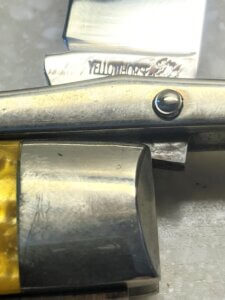
Figure 12. A Queen swing guard in gold Corian plastic by Micheal Prater showing the mark side tang stamp for Yellowhorse cutlery, with a horses’ head beside the lettering. (this photo demonstrates that is often a problem on swing guard knives, since they interfere with getting a good look at tang stamps) The pile side of this knife shows a Queen cutlery arched tang stamp and Titusville, PA. In fact, only one knife shows any custom work by Yellowhorse – the deal was probably not completely finalized at the time the tangs were struck.
We will show only a few samples of the two basic types of knives; Corian acrylic versions (12 versions) and embedded minerals, metals in acrylic with decorated bolsters in the other (6).
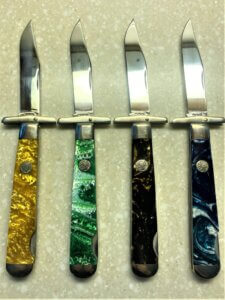
Figure 13. Four Queen swing guards in multi colors of Corian plastic. From left, first, meteor shower/gold swirl; second, Emerald ice/green white swirl; third, Halloween/black, orange and gold; fourth, Pacific Blue/Blue, white teal.
In addition to the four models shown above, there are eight other color handle variations:
Alaska Blue/blue and white swirl Corian
Purple Eggshell acrylic
Black Eggshell acrylic
Blue Eggshell acrylic
Atlantic Sunset/blue and red swirl Corian
Groovy/green red swirl Corian
Merlin fire mist/mica pearl Corian
Western Sky Corian
These knives came with no labels and no boxes (only thin clear vinyl sleeves) and sellers were quick to invent names, so there is no valid way to guess what names you might find these knives with. The Queen shields were glued in (not pinned) and might not be present.
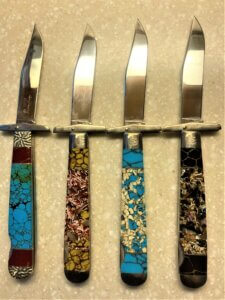
Figure 14. Yellowhorse and Micheal Prater/Painted Pony swing guard versions of fancier handle finishes. The knife at the far left, shows Brian Yellowhorse custom etch on the blade and modified bolsters. The hidden (pile) side shows a large feather in nickel silver. The others are described below.
From the right of the first Yellowhorse with custom bolsters, figure 14 shows three handles with embedded minerals of different sorts, divided by thin metal strips and embedded in polished acrylic. The second knife is made with red jasper and oyster shell; the third is turquoise and oyster shell; fourth is “Apache gold and eggshell. The pile side top bolster of the three painted Pony knives show a deep etch of a pony as can be seen in Figure 14. Two knives of this set are not pictured, with red eggshell and yellow mineral, and dinosaur bone and jasper.
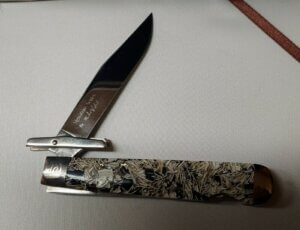
Figure 15. A Micheal Prater Queen swing guard with an etched signature on the blade and a dark eggshell acrylic handle, with Painted Pony bolster etch, that seems to be of the same series. There might still be example of this series that we have not seen.
The Yellowhporse/Pratrer knives feature a clean and modern look, (no blade etch, or guard stamp, or brass handle pins), but with nickel silver liners, high polished blades/handles, and eye-popping color on the handles, they are easily the most modern treatment the Queen swing guard has ever received. When others visit my collection, these are always the first knives mentioned. My grandchildren greatly admire them. Traditionalists might have some doubts, though in the nearly 10 years since their arrival, they have also increased in price.
These knives have several cost savings in production and certainly, more choice for consumers. With stainless blade and plastic handle, they represent another everyday carry (EDC) option to the stabilized wood/Delrin catalog knives. In fact, in a conversation with Michael Prater about these knives, (back in 2015), he stressed that if any customer had one of these Corian or acrylic handles break, contact him (Painted Pony.com) his company would repair that knife at no cost. He thought that they were quite durable. While I have not checked if that offer is still current, it does reinforce the idea that these could easily be user knives if sharpened.
These knives were marketed so hard across many Internet sellers, in very small editions, in a short period of time, that it would have been extremely hard to ever acquire a “full set.” There were simply too many in terms of both money and time to find them.

Figure 16. A prototype rare swing guard with powder coated serrated clip blade with linen micarta olive green handle, an edition of 3 for Reed Cutlery. (Internet photo).
Reed Cutlery. Ordered a very unusual swing guard, shifting the design to a very modern “tactical” style with a blackened serrated clip blade using the olive green linen micarta handle that queen introduced in 2013. There were only three of this knife made, according to a Ken Daniels authenticity certificate, but no date to state when this knife was made.. Sadly, Mr. Daniel Reed, an active Knife seller, died suddenly and Queen, of course, did not last either. It would have been interesting to see what might have happened to this old pattern in the coming years.
Conclusions on Special Factory Orders
The number of knife club groups SFO’s producing swing guard knives was twelve that we know of. Knife collecting clubs make small purchases, and were frequently attracted to early Schatt & Morgan annual knives. I do not see any evidence, so far beyond two SFO club knives sponsors per year in the Schatt & Morgan Series or File and Wire Series, but there is always some chance more of these knives will come out into the marketplace. We have not found any club knives for the 1994 orange corncob swing guard. This market provided the company with an extra outlet for a highly-finished knife with very few changes – often just a different blade etch, bolster etch, or shield. Many of these knives are finely finished, and have been stored well. They are often a good value, especially if the club or etch carries meaning for you. My absolute favorite among this group is the Alleghany Mountain Knife Collectors 1993 “I survived the blizzard of ’93” with a big snowman on the blade (the lowest knife in Figure 1, above). I was in that storm, happy to be alive after a major heart attack, watching as neighbors shoveled my driveway.
The commercial knife sellers totaled only seven in our summary, but they have had a huge impact in number of units and creativity and beauty in knives they ordered. The first five years of the 21st century seem to have been characterized by these innovations by Clarence Risner, Sooner State knives, and by Wolverine Knife Collectors Club, when a former folding hunting became a standard collector knife, with blade changes and superior handle materials.
This article concludes our survey of antique Schatt & Morgan and modern Queen swing guards with a currently estimated number of 123 different versions of the pattern. We have seen that the largest number were built off Queen’s re-introduction of the old Schatt & Morgan swing guard. It is very likely that many different models are still hiding in private collections to this day. So, Queen “hit a home run” and had cutlers that could make a knife that many wanted. It has provided an ongoing playground for collectors of this knife.
Queen management, especially in the last five years, was busy following American cutleries plan to make ever more “Limited Edition Knives.” In the early ‘90s Queen was working with editions of around 600, but by the end, they were producing editions of 30, 25, or even 10 units. In preparation for the changes of a model or actual prototypes a number of “trials” have resulted and if they can be validated, those knives will continue to gain value.
This characteristic of making small runs is one of the more frustrating, but most interesting aspect of Queen’s production. Their business model, especially in their last years, unfortunately increases the demands on pattern collectors, especially if one is enamored of “completion.” No collection can be considered completed. (A useful motto for shirt or ballcap for pattern knife collectors might be “Abandon Completion of your collection– Just Love the Knives you can get”). Another option is for any collector to focus the purpose of their collecting. It would be hard to go wrong with the early catalog knives; more items in circulation, and modest numbers to be “complete.”
For me, since the completion of a collection, becomes too expensive and very little hope of “success,” I plan to start paying much more attention to the things I like about each knife I do choose to own. I am going to display them, look at each one, handle it, maintain it – not just put it away as future money. Certainly, as price and rarity go up, so also do my demands for quality of manufacture. “Look at your Knife.” I mean “LOOK AT YOUR KNIFE”. The appeal of each individual knife will need to start replacing the sense of “completion” for me. As you can see in Internet photos in these articles, my other strategy is to become a “virtual collector,” find a photo and add that to my set – sort of satisfying and much less expensive.
Of course, as the variability of available knives grows, it allows more personalization of any given collection. And some focus, as well as some rarity, does improve a collection in some peoples’ mind. There is also a bit of adventure in the search, and the strange, circuitous routes some of these knives take in getting to the eyes of collectors. This also means that learning as much as you can about the provenance -the pattern of ownership before you- has gained in importance.
NOTE. This is the 3rd article on Queen Swing guards. The first is a history of the pattern from Schatt & Morgan, Queen City, and Queen until 1991. The 2nd is a summary of Queen Catalog and special Project swing guards 1992-2017, both listed as “blogs”. The 4th is listed under “knife articles” in our website since Excel files do not seem to load well as Blogs. If you have any suggestions for improving this article or adding new swing guards to any of these articles, pl3ease do not hesitate to contact us. Thank you.
References
Collector Knives for Queen Cutlery & Servotronics, 1988 -1998. – Queen Cutlery Guide.

